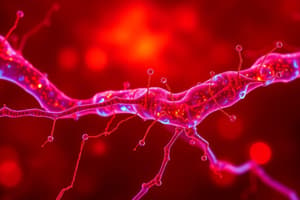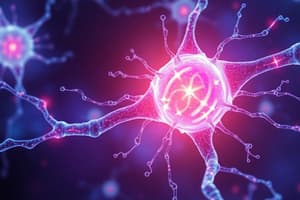Podcast
Questions and Answers
What is the biggest barrier in the process of cellular communication signals being transmitted across the environment?
What is the biggest barrier in the process of cellular communication signals being transmitted across the environment?
- Nucleus
- Endoplasmic reticulum
- Cytoplasm
- Cell membrane (correct)
Which mode of cell stimuli reception is observable in cancer cells and involves signals from a cell to its own receptors?
Which mode of cell stimuli reception is observable in cancer cells and involves signals from a cell to its own receptors?
- Autocrine cells (correct)
- Neuronal/Synaptic
- Paracrine signals
- Endocrine signals
Which mode of cell stimuli reception targets cells nearby by secreting soluble molecules which are able to diffuse in?
Which mode of cell stimuli reception targets cells nearby by secreting soluble molecules which are able to diffuse in?
- Endocrine signals
- Autocrine cells
- Paracrine signals (correct)
- Neuronal/Synaptic
Which mode of cell stimuli reception targets cells that are further away and travels through the bloodstream to target cells?
Which mode of cell stimuli reception targets cells that are further away and travels through the bloodstream to target cells?
Which mode of cell stimuli reception delivers messages over long distances but does not broadcast widely, instead delivering quickly and specifically to individual target cells?
Which mode of cell stimuli reception delivers messages over long distances but does not broadcast widely, instead delivering quickly and specifically to individual target cells?
In which mode of cell stimuli reception do receptor and signal molecules generally reside on the surface and both need to be in close contact for the signal to pass?
In which mode of cell stimuli reception do receptor and signal molecules generally reside on the surface and both need to be in close contact for the signal to pass?
What are receptors in cellular communication signals?
What are receptors in cellular communication signals?
What is the process whereby one type of signal is converted to another within a cell?
What is the process whereby one type of signal is converted to another within a cell?
Which type of signal molecule requires receptors on the surface of target cells?
Which type of signal molecule requires receptors on the surface of target cells?
What type of receptor can bind more than one ligand?
What type of receptor can bind more than one ligand?
What is the main role of accessory proteins in the GTPase cycle?
What is the main role of accessory proteins in the GTPase cycle?
Which process is necessary to prevent prolonged stimulation, damage, or cell death?
Which process is necessary to prevent prolonged stimulation, damage, or cell death?
What pathway involves a ligand activating the receptor and initiating a cascade of phosphorylations that transmit the signal downstream?
What pathway involves a ligand activating the receptor and initiating a cascade of phosphorylations that transmit the signal downstream?
What is the role of phosphatases in cell signaling?
What is the role of phosphatases in cell signaling?
Cellular communication signals are primarily transmitted through the release of gaseous molecules.
Cellular communication signals are primarily transmitted through the release of gaseous molecules.
Endocrine signals target cells that are nearby and can diffuse through the extracellular environment.
Endocrine signals target cells that are nearby and can diffuse through the extracellular environment.
Receptors are peripheral proteins that are not directly involved in signal transduction.
Receptors are peripheral proteins that are not directly involved in signal transduction.
Neuronal/synaptic mode of cell stimuli reception involves the widespread broadcast of messages to multiple target cells.
Neuronal/synaptic mode of cell stimuli reception involves the widespread broadcast of messages to multiple target cells.
Autocrine cells only receive signals from other nearby cells and not from their own receptors.
Autocrine cells only receive signals from other nearby cells and not from their own receptors.
Receptors can only be located on the cell surface and not intracellularly.
Receptors can only be located on the cell surface and not intracellularly.
All ligands are large, hydrophilic molecules that cannot cross the plasma membrane.
All ligands are large, hydrophilic molecules that cannot cross the plasma membrane.
Signal transduction is the process whereby one type of signal is converted to another outside of a cell.
Signal transduction is the process whereby one type of signal is converted to another outside of a cell.
Receptor tyrosine kinases (RTKs) do not contain an intracellular kinase domain.
Receptor tyrosine kinases (RTKs) do not contain an intracellular kinase domain.
Phosphorylation is an irreversible process that cannot be reversed through phosphatases.
Phosphorylation is an irreversible process that cannot be reversed through phosphatases.
Flashcards
Receptor Location
Receptor Location
Receptors can be located on the cell surface or intracellularly.
Extracellular Signal Molecules
Extracellular Signal Molecules
Large, hydrophilic molecules (can't cross membrane) need surface receptors; small, hydrophobic molecules can pass through and bind intracellular receptors.
Ligands
Ligands
Molecules that bind to receptors; can be dissolved gases, amino acids, or fatty acids.
Signal Transduction
Signal Transduction
Signup and view all the flashcards
Receptor Binding Site
Receptor Binding Site
Signup and view all the flashcards
Agonist
Agonist
Signup and view all the flashcards
Antagonist
Antagonist
Signup and view all the flashcards
Intracellular Mediators
Intracellular Mediators
Signup and view all the flashcards
Effector Enzymes
Effector Enzymes
Signup and view all the flashcards
Secondary Messengers
Secondary Messengers
Signup and view all the flashcards
Ligand-Gated Ion Channels
Ligand-Gated Ion Channels
Signup and view all the flashcards
G Protein-Coupled Receptors
G Protein-Coupled Receptors
Signup and view all the flashcards
Receptor Tyrosine Kinases (RTKs)
Receptor Tyrosine Kinases (RTKs)
Signup and view all the flashcards
Phosphorylation
Phosphorylation
Signup and view all the flashcards
Phosphatases
Phosphatases
Signup and view all the flashcards
Monomeric GTPases
Monomeric GTPases
Signup and view all the flashcards
MAPK Pathway
MAPK Pathway
Signup and view all the flashcards
Signal Termination
Signal Termination
Signup and view all the flashcards
Cell Response
Cell Response
Signup and view all the flashcards
Study Notes
-
Receptors have intracellular regions that interact with effectors, and can be located on the cell surface or intracellularly.
-
Two types of extracellular signal molecules exist: large, hydrophilic molecules that cannot cross the plasma membrane and require receptors on the surface of target cells, and small, hydrophobic molecules that can pass through the plasma membrane and bind to intracellular receptor proteins.
-
Examples of ligands include dissolved gases, amino acids, and fatty acids.
-
Signal transduction is the process whereby one type of signal is converted to another within a cell.
-
Receptor proteins contain at least one binding site for ligands, and a ligand can either activate (agonist) or repress (antagonist) a physiological response.
-
Receptors communicate the binding of a ligand to the cell and initiate cell signaling.
-
Signal transduction involves the activation of intracellular mediators, which transmit the signal to effector enzymes that bring about changes.
-
Secondary messengers alter metabolism or affect effector enzymes that activate target proteins, altering gene transcription.
-
There are three types of receptors: ligand-gated ion channels, G protein-coupled receptors, and receptor tyrosine kinases (RTKs).
-
RTKs are transmembrane receptors with an extracellular part where ligands bind, a transmembrane domain, and an intracellular kinase domain.
-
RTKs phosphorylate tyrosine residues using ATP, adding phosphate groups to specific amino acids.
-
Phosphorylation can activate or deactivate proteins and is reversible through phosphatases.
-
RTKs can also use monomeric GTPases as molecular switches, with activated GTPases relaying signals further.
-
Accessory proteins are needed for the GTPase cycle to take place.
-
Phosphorylation and GTP binding act as molecular switches and both need to be turned off.
-
The MAPK pathway is a signaling pathway in which a ligand activates the receptor, initiating a cascade of phosphorylations that transmit the signal downstream and activate target proteins.
-
Signal termination is necessary to prevent prolonged stimulation, damage, or cell death, and can occur through endocytosis, downregulation, inactivation, or production of inhibitory proteins.
-
Some receptors can bind more than one ligand or vice versa, and each cell responds to a limited set of extracellular signals.
-
Receptors have intracellular regions that interact with effectors, and can be located on the cell surface or intracellularly.
-
Two types of extracellular signal molecules exist: large, hydrophilic molecules that cannot cross the plasma membrane and require receptors on the surface of target cells, and small, hydrophobic molecules that can pass through the plasma membrane and bind to intracellular receptor proteins.
-
Examples of ligands include dissolved gases, amino acids, and fatty acids.
-
Signal transduction is the process whereby one type of signal is converted to another within a cell.
-
Receptor proteins contain at least one binding site for ligands, and a ligand can either activate (agonist) or repress (antagonist) a physiological response.
-
Receptors communicate the binding of a ligand to the cell and initiate cell signaling.
-
Signal transduction involves the activation of intracellular mediators, which transmit the signal to effector enzymes that bring about changes.
-
Secondary messengers alter metabolism or affect effector enzymes that activate target proteins, altering gene transcription.
-
There are three types of receptors: ligand-gated ion channels, G protein-coupled receptors, and receptor tyrosine kinases (RTKs).
-
RTKs are transmembrane receptors with an extracellular part where ligands bind, a transmembrane domain, and an intracellular kinase domain.
-
RTKs phosphorylate tyrosine residues using ATP, adding phosphate groups to specific amino acids.
-
Phosphorylation can activate or deactivate proteins and is reversible through phosphatases.
-
RTKs can also use monomeric GTPases as molecular switches, with activated GTPases relaying signals further.
-
Accessory proteins are needed for the GTPase cycle to take place.
-
Phosphorylation and GTP binding act as molecular switches and both need to be turned off.
-
The MAPK pathway is a signaling pathway in which a ligand activates the receptor, initiating a cascade of phosphorylations that transmit the signal downstream and activate target proteins.
-
Signal termination is necessary to prevent prolonged stimulation, damage, or cell death, and can occur through endocytosis, downregulation, inactivation, or production of inhibitory proteins.
-
Some receptors can bind more than one ligand or vice versa, and each cell responds to a limited set of extracellular signals.
Studying That Suits You
Use AI to generate personalized quizzes and flashcards to suit your learning preferences.




